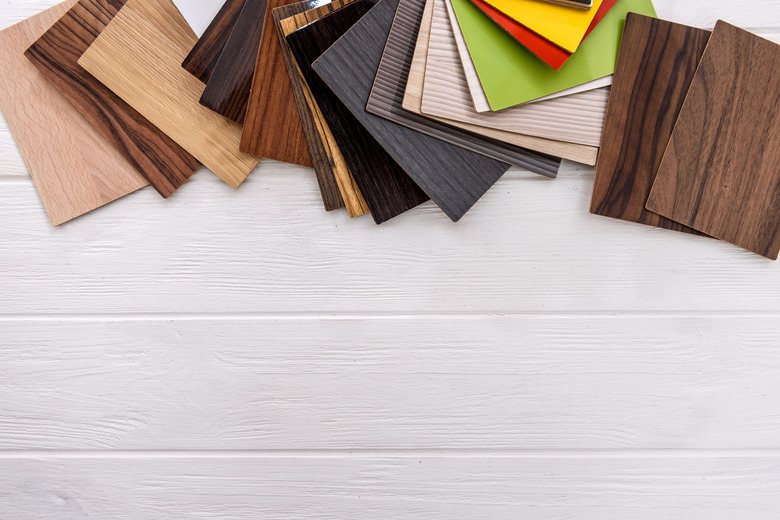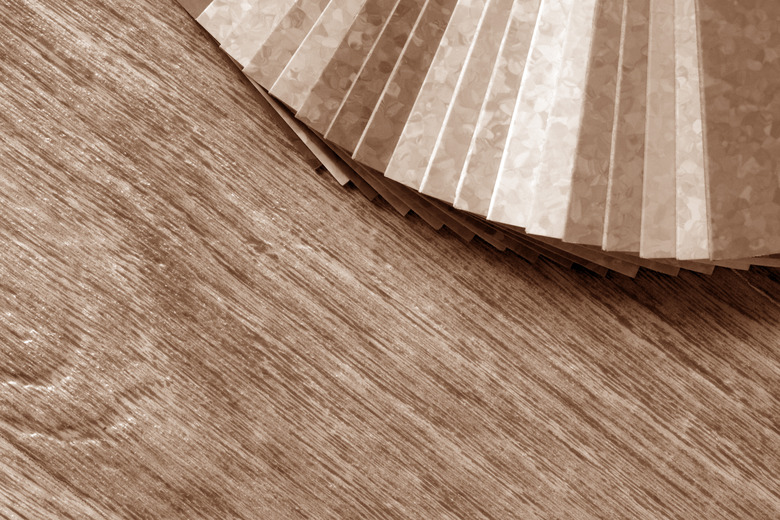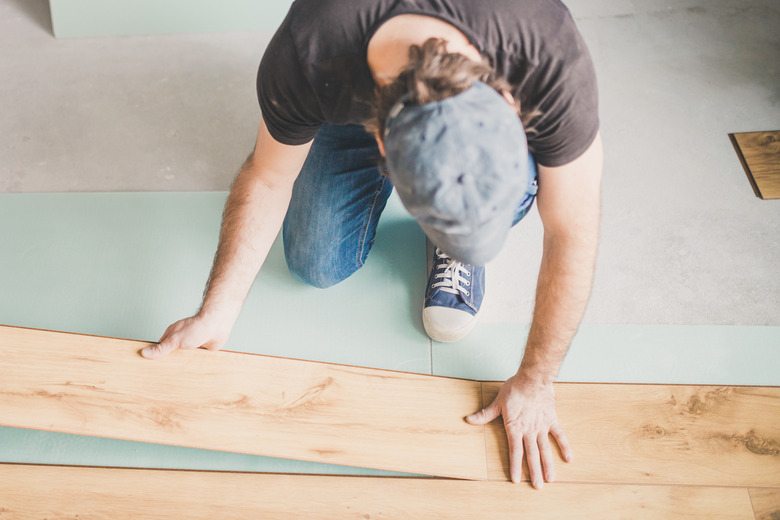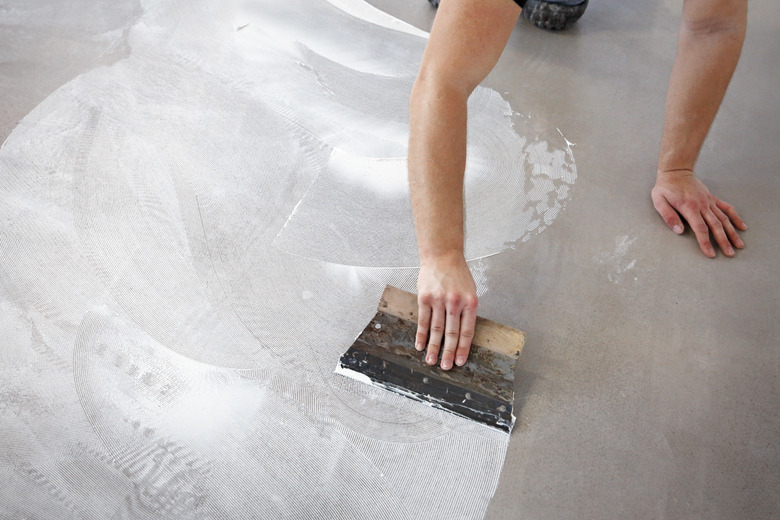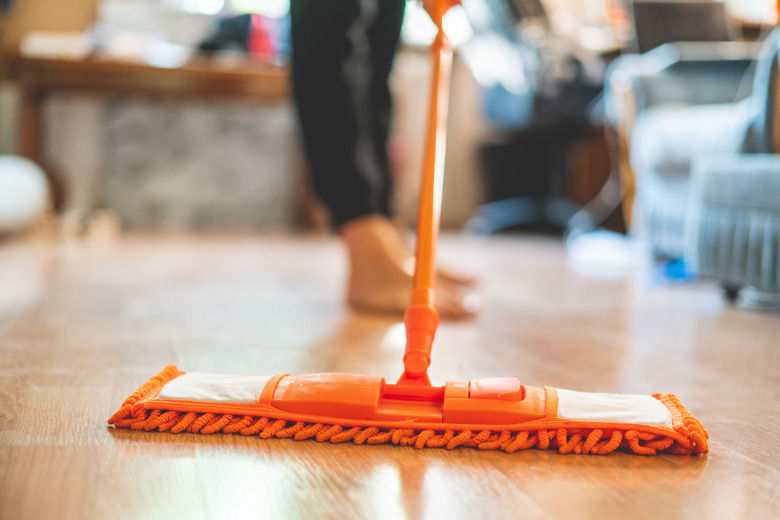Linoleum Vs. Laminate Flooring
While some use the terms linoleum and laminate flooring interchangeably, these two are in fact very different materials. Linoleum is made from a mixture of linseed oil and various tree and plant bits, while laminate flooring is built in layers, including one "image" layer that emulates the look of wood or other materials. They're both relatively easy to care for, but laminate installation is much easier to manage as a first-time DIY project.
Linoleum Floor Composition
Linoleum Floor Composition
Linoleum floors are made from an interesting combination of materials. Linseed oil makes up a major portion of the material. Bits of cork, wood, jute and tree resins make up the rest, resulting in a resilient type of flooring that stands the test of time, with proper care.
The original linoleum flooring came about in the late 1800s after Frederick Walton tinkered extensively with linseed oil and additives until he created a durable product. It proved so popular that he opened a series of linoleum shops around London, exporting as far as the United States. Eventually others came up with their own formulations to make the product even more durable and cost effective.
Linoleum: Pros and Cons
Linoleum: Pros and Cons
Linoleum is an excellent floor choice for any room that isn't terribly humid, as it can last for decades. It is also water-resistant when its seams are properly sealed. For allergy sufferers, linoleum is among the best flooring options, as it is hypo-allergenic and naturally resists mold and mildew. As a relatively hard surface, it is easy to clean and keep free of dust and potential allergens with regular dusting, sweeping. and washing.
On the downside, linoleum sheets may be difficult for the average homeowner to install as a DIY project, as the sheets must be cut with a sharp utility knife or linoleum cutter. Spreading the adhesive properly requires some skill—best acquired over numerous installs—so it is best installed by a professional. Installing sheet linoleum also requires a very smooth and clean surface, as even a small pebble or nail head may eventually "telegraph" and cause a bump or other damage in the surface of the linoleum.
Laminate Floor Composition
Laminate Floor Composition
Laminate flooring is usually made of four separate layers of material fused together into a durable flooring product. The bottom layer is a backing that seals the entire laminate board, adding stability so the board stays straight. Some laminate boards also have a foam on the bottom that eliminates the need for underlayment. The next layer is either high density or medium density fiberboard (HDF or MDF), which provides the bulk and strength of the flooring.
A decorative paper layer atop the fiberboard gives the laminate the look of wood, stone or virtually any other printable image. A clear top layer, sometimes made of aluminum oxide, protects the image layer from scuffs, scratches, spills and ultraviolet rays.
Laminate flooring is also not the same thing as luxury vinyl flooring, although both can have a printed image that gives them a particular look or style. Vinyl flooring is much more moisture-resistant and is the better choice for high-humidity areas such as a bathroom.
Laminate: Pros and Cons
Laminate: Pros and Cons
Laminate flooring is another good choice because of its ease of care and the numerous style options available. The variety of looks and colors available in laminate far outweigh the options for linoleum. If you enjoy the look of a hardwood floor, there are many faux wood options for laminate flooring, emulating just about any type of wood grain and coloring imaginable. Laminate is also easier to install than most linoleum floor options, even for the complete novice. It requires no glue or fasteners, as it's a floating floor. The pieces snap together.
On the downside, inexpensive laminate flooring may not last as long as linoleum, and certainly not as long as an actual wood floor. Cheap laminate flooring may wear out in some areas in as little as 10 years.
Cost and Installation Comparisons
Cost and Installation Comparisons
When it comes to both linoleum and laminate flooring, the pricing options vary quite a bit. Linoleum averages $4 to $10 per square foot in tile form. In its more common sheet form, it averages $25 to $50 per square yard. Laminate flooring ranges from 50 cents per square foot for the least durable budget versions to $5 per square foot for more durable flooring.
Installing linoleum tiles can be tricky, but proper planning makes it a bit easier. Start your tile pattern in the center of the room, setting down a small stack of tiles without adhesive to come up with a desirable "dry fit" alignment. Once happy with it, use chalk line to mark out a grid pattern. Working in stages, apply several square feet of adhesive over the substrate, then smooth the tiles down atop the adhesive.
Linoleum sheets are far harder to install, since they require a weighted roller to smooth the sheeting down after installation. Sheet linoleum may be a bit less forgiving than tile in some ways, as it's more difficult to swap out a piece for a fresh piece if, for instance, a cut is incorrect.
By contrast, laminate flooring planks are designed to fit together with notches and grooves along the length of each plank. Some products have an underlayment already attached; others require that you install an underlayment over the substrate before installation. Laminate must be acclimated, or left to sit, at room temperature for 48 hours before installation. Laminate expands and contracts when installed since it is a floating floor, not glued down. Installation typically begins along the longest (focal) wall, rather than in the center of the room. Stagger the planks as you would with wood flooring, trimming the first and last pieces that butt against the end walls ahead of time.
Care and Longevity Comparisons
Care and Longevity Comparisons
Both linoleum and laminate should be dusted and swept regularly to help prevent scrapes and scratches, especially before washing.
Linoleum may be washed with just water, applied with a damp, not wet, mop. A pH-neutral cleaner may be mixed with the water when washing dirtier floors. Laminate flooring is washed in much the same manner. In each case, it's important not to soak the floor, as too much moisture may damage the flooring or seep beneath seams and cause additional problems. Cleaning products designed specifically for linoleum or laminate are widely available.
As far as lifespan goes, virtually any floor can last a long time, provided you care for it according to manufacturer recommendations—especially in a home that's free of pets or young children.
Linoleum lasts for decades or even generations when extra precautions are taken, such as avoiding harsh cleaning products and cleaning up potentially staining spills as soon as they happen. The longevity of linoleum owes mostly to the nature of its construction—linoleum is solid material through its entire thickness, so the color and design will not wear off, even after years of heavy foot traffic and washing. Many manufacturers recommend a coat of sealant every few years or so to help protect the floor's longevity.
Laminate flooring materials face something of a challenge, as even top-quality laminates can have their top protective layer worn through by high foot traffic or furniture. When this happens, there is no way to refinish the surface so the flooring must be replaced. Still, better quality laminates with thick wear layers can last for decades, while inexpensive laminate flooring rarely lasts more than 10 to 15 years. The higher the AC (abrasion class) grade, the more durable the laminate will be.
References
- Floor Coverings International: The History of Linoleum Flooring
- Parterre: Luxury Vinyl Vs. Laminate Flooring
- Swiss Krono: What is Laminate Flooring and How is it Made?
- Armstrong Flooring: What's The Difference Between Linoleum and Vinyl Flooring?
- Fine Homebuilding: What's the Difference: Linoleum vs. Vinyl
- Rempros: How Long does Laminate Flooring Last?
- Old House Online: How to Lay Linoleum Tile
- Forbo: Marmoleum Sheet Installation Guide
- Home Depot: How to Install Laminate Flooring
